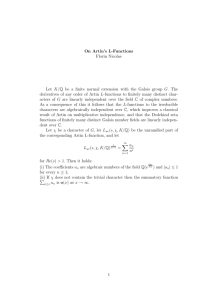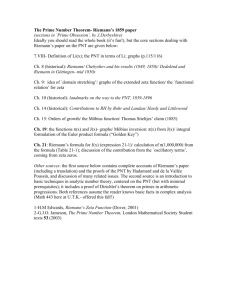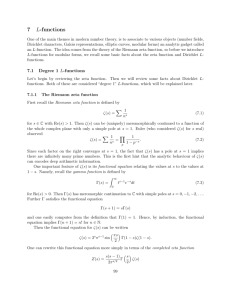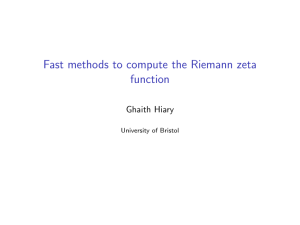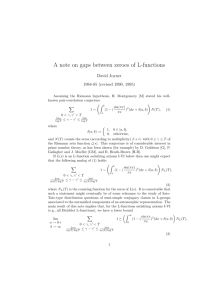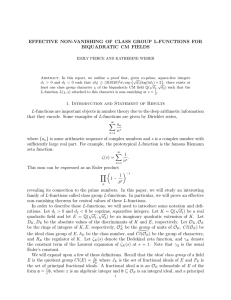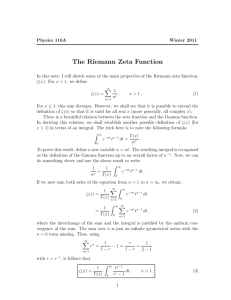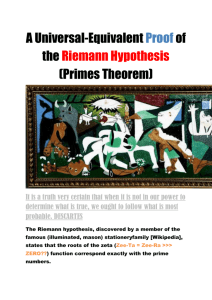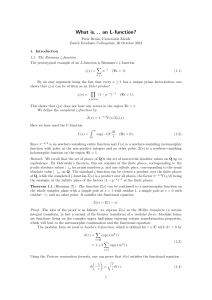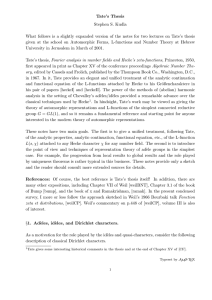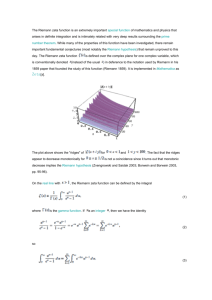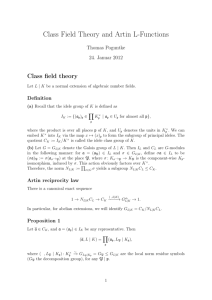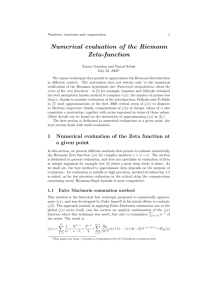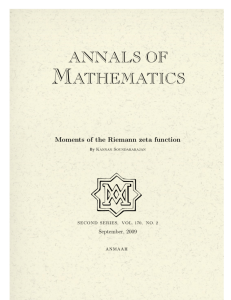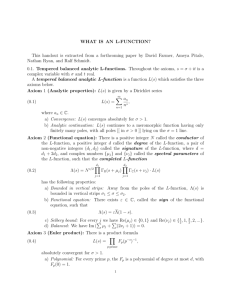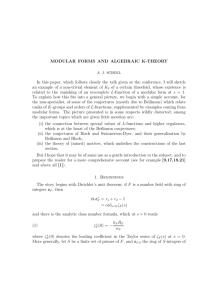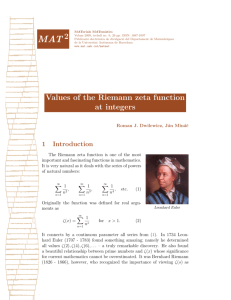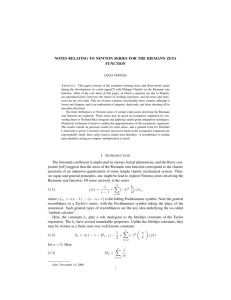SEMINAR “L-FUNCTIONS” The theory of L
advertisement
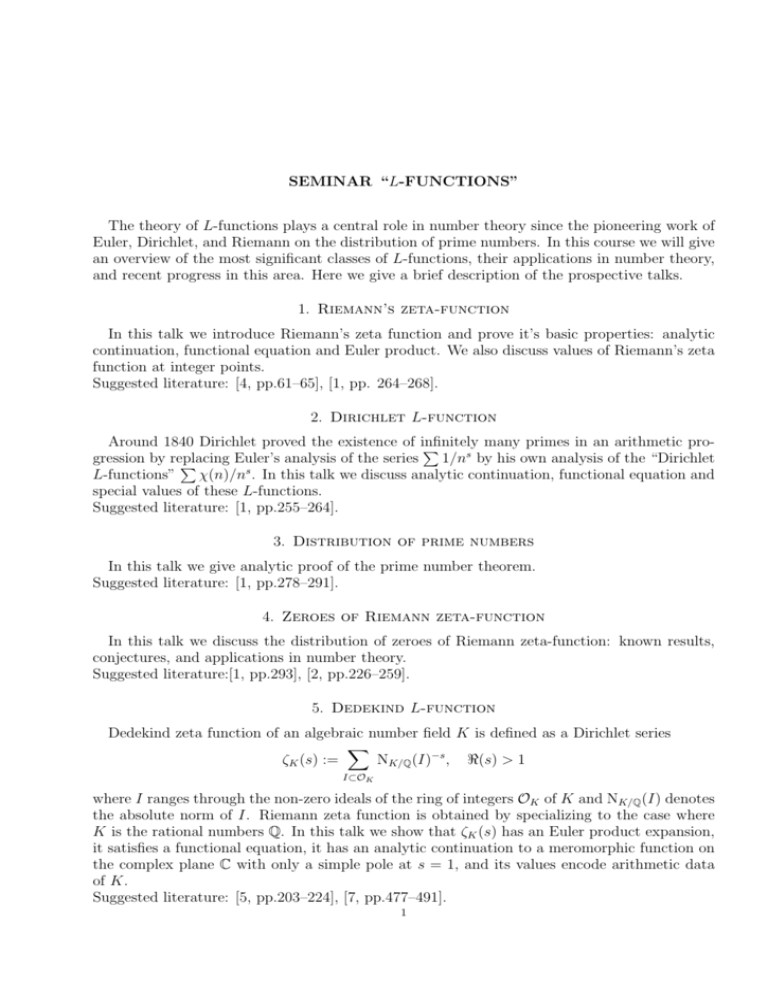
SEMINAR “L-FUNCTIONS” The theory of L-functions plays a central role in number theory since the pioneering work of Euler, Dirichlet, and Riemann on the distribution of prime numbers. In this course we will give an overview of the most significant classes of L-functions, their applications in number theory, and recent progress in this area. Here we give a brief description of the prospective talks. 1. Riemann’s zeta-function In this talk we introduce Riemann’s zeta function and prove it’s basic properties: analytic continuation, functional equation and Euler product. We also discuss values of Riemann’s zeta function at integer points. Suggested literature: [4, pp.61–65], [1, pp. 264–268]. 2. Dirichlet L-function Around 1840 Dirichlet proved the existence of infinitely many primes in an arithmetic proP s gression by replacing Euler’s analysis of the series 1/n by his own analysis of the “Dirichlet P L-functions” χ(n)/ns . In this talk we discuss analytic continuation, functional equation and special values of these L-functions. Suggested literature: [1, pp.255–264]. 3. Distribution of prime numbers In this talk we give analytic proof of the prime number theorem. Suggested literature: [1, pp.278–291]. 4. Zeroes of Riemann zeta-function In this talk we discuss the distribution of zeroes of Riemann zeta-function: known results, conjectures, and applications in number theory. Suggested literature:[1, pp.293], [2, pp.226–259]. 5. Dedekind L-function Dedekind zeta function of an algebraic number field K is defined as a Dirichlet series X ζK (s) := NK/Q (I)−s , <(s) > 1 I⊂OK where I ranges through the non-zero ideals of the ring of integers OK of K and NK/Q (I) denotes the absolute norm of I. Riemann zeta function is obtained by specializing to the case where K is the rational numbers Q. In this talk we show that ζK (s) has an Euler product expansion, it satisfies a functional equation, it has an analytic continuation to a meromorphic function on the complex plane C with only a simple pole at s = 1, and its values encode arithmetic data of K. Suggested literature: [5, pp.203–224], [7, pp.477–491]. 1 2 SEMINAR “L-FUNCTIONS” 6. Modular forms In this talk we introduce the notion of a modular form. We give first examples of modular forms (e.g. theta series and Eisenstein series), discuss the Fourier expansion of a modular form, and compute vector spaces of modular forms of level 1 and given weight. Suggested literature: [5, pp.3–18], [4, pp.70–74]. 7. Converse theorems of Hamburger, Hecke, and Weil The next point of the theory is that the functional equation for Riemann zeta function nearly characterizes it. Indeed, Hamburger showed in 1921 that any Dirichlet series satisfying ζ’s functional equation and suitable regularity conditions is necessarily a constant multiple of ζ(s). Hamburger’s Converse Theorem did not become completely understood until greatly generalized by Hecke in 1936. A. Weil in 1967 completed Hecke’s theory by similarly characterizing modular forms for congruence subgroups, such as Γ0 (N ). In this talk we prove converse theorems of Hamburger and Hecke and state Weil’s converse theorem. Suggested literature: [4, pp.66–68 and 70–75]. 8. Congruence zeta function and Hasse-Weil L-function In this talk we introduce congruence zeta function of a projective variety over a finite field. Also we discuss Weil’s conjectures famously proved by P. Deligne. Finally, we introduce the Hasse-Weil L-function for a projective variety over a global field. Suggested literature: [6, pp.51–54]. 9. Congruence zeta function function of elliptic curve In this section we compute congruence zeta function for a class of elliptic curves. Suggested literature: [6, pp.56–61]. 10. Modularity theorem In this talk we formulate the modularity theorem for elliptic curves famously proved by A.Wiles et. al. We give a simple proof for special curves, the so called congruent number curves. Suggested literature: [5, pp.133–143] or [6, pp.79–88]. 11. Artin L-function and Artin conjecture Artin L-function is a type of Dirichlet series associated to a linear representation of a Galois group G. These functions were introduced in the 1923 by Emil Artin, in connection with his research into class field theory. In this talk we introduce Artin L-function, prove its basic properties, and discuss Artin conjectures. Suggested literature: [7, pp.517–527], [8]. 12. Langland’s program Langlands program is a web of conjectures that relate Galois groups in algebraic number theory to automorphic forms and representation theory of algebraic groups over local fields and adeles. The purpose of this talk is to give an elementary introduction to Langlands program. Suggested literature: [3]. SEMINAR “L-FUNCTIONS” 3 References [1] T.M. Apostol, Introduction to analytic number theory, Springer 1976 [2] H. M. Edwards, Riemanns zeta function, Academic Press, New York-London, 1974. [3] S. S. Gelbart, An elementary introduction to the Langlands program, Bull. Amer. Math. Soc. 10 (1984), 177–219 [4] S. S. Gelbardt, S. Miller, Riemanns zeta function and beyond, Bulletin of the American Mathematical Society, Volume 41, Number 1 (2003) [5] H. Iwaniec,Topics in classical automorphic forms, A.M.S., Providence, RI, 1997 [6] N. Koblitz, Introduction to Elliptic Curves and Modular Forms, Springer, Berlin, 1993. [7] J. Neukirch, Algebraic number theory, Springer 1992 [8] H.M. Stark, Galois theory, algebraic numbers and zeta functions, in: From number theory to physics, Springer 1989, 313–393


